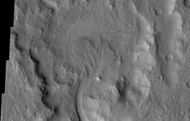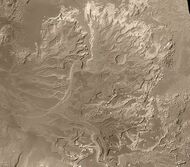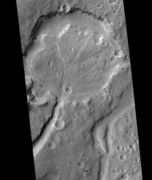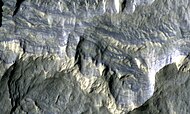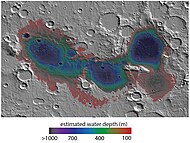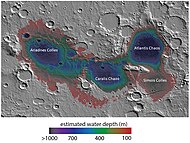Difference between revisions of "Lakes on Mars"
(tired to create new article with info, ref, and images) |
|||
| Line 7: | Line 7: | ||
==Images of possible deltas== | ==Images of possible deltas== | ||
<gallery class="center" widths="190px" heights="180px"> | <gallery class="center" widths="190px" heights="180px"> | ||
| + | |||
Image:Delta in Margaritifer Sinus.jpg|Possible delta in [[Margaritifer Sinus quadrangle]] as seen by THEMIS. | Image:Delta in Margaritifer Sinus.jpg|Possible delta in [[Margaritifer Sinus quadrangle]] as seen by THEMIS. | ||
| − | Image:Distributary fan-delta.jpg|Probable delta in | + | Image:Distributary fan-delta.jpg|Probable delta in Eberswalde Crater that lies to the NE of Holden Crater, as seen by Mars Global Surveyor. Image in [[Margaritifer Sinus quadrangle]]. |
Image:Delta in Lunae Palus.jpg|Delta in [[Lunae Palus quadrangle]], as seen by THEMIS. | Image:Delta in Lunae Palus.jpg|Delta in [[Lunae Palus quadrangle]], as seen by THEMIS. | ||
Image:Delta as seen by HiRISE.jpg|Delta that fills a crater in [[Lunae Palus quadrangle]], as seen by HiRISE. | Image:Delta as seen by HiRISE.jpg|Delta that fills a crater in [[Lunae Palus quadrangle]], as seen by HiRISE. | ||
Image:605555-PIA15097-JezeroCrater-Delta.jpg|[[Jezero crater]] delta - chemical alteration by water ([[:File:260184-JezeroCrater-Delta-Full.jpg|hi-res]]) | Image:605555-PIA15097-JezeroCrater-Delta.jpg|[[Jezero crater]] delta - chemical alteration by water ([[:File:260184-JezeroCrater-Delta-Full.jpg|hi-res]]) | ||
| + | |||
</gallery> | </gallery> | ||
| + | |||
Some places that are believed to have once held lakes are Holden Crater, [[Jezero Crater]], [[Gale Crater]], Ritchey Crater, Columbus crater, [[Valles Marineris]], Argyre basin, Hellas Basin, and large areas in Eridania. | Some places that are believed to have once held lakes are Holden Crater, [[Jezero Crater]], [[Gale Crater]], Ritchey Crater, Columbus crater, [[Valles Marineris]], Argyre basin, Hellas Basin, and large areas in Eridania. | ||
| + | |||
<gallery class="center" widths="190px" heights="180px"> | <gallery class="center" widths="190px" heights="180px"> | ||
Image:Columbus Crater Layers.JPG|Columbus Crater Layers, as seen by [[HiRISE]]. This false-color image is about 800 feet across. Some of the layers contain hydrated minerals. | Image:Columbus Crater Layers.JPG|Columbus Crater Layers, as seen by [[HiRISE]]. This false-color image is about 800 feet across. Some of the layers contain hydrated minerals. | ||
| Line 20: | Line 24: | ||
Image:Holden Crater Close-up.JPG|Close-up of Channels on Rim of Holden Crater, as seen by THEMIS. Image is located in the [[Margaritifer Sinus quadrangle]]. | Image:Holden Crater Close-up.JPG|Close-up of Channels on Rim of Holden Crater, as seen by THEMIS. Image is located in the [[Margaritifer Sinus quadrangle]]. | ||
</gallery> | </gallery> | ||
| + | |||
[[File:PIA16768-MarsCuriosityRover-AeolisMons-20120920.jpg|600pxr|Wide view of Mt. Sharp]] | [[File:PIA16768-MarsCuriosityRover-AeolisMons-20120920.jpg|600pxr|Wide view of Mt. Sharp]] | ||
| + | |||
| + | Wide view of Mt. Sharp in Gale Crater | ||
| + | |||
<gallery class="center" widths="190px" heights="180px"> | <gallery class="center" widths="190px" heights="180px"> | ||
PIA22059 fig1eridaniadepths.jpg|Map showing estimated water depth in different parts of Eridania Sea This map is about 530 miles across. | PIA22059 fig1eridaniadepths.jpg|Map showing estimated water depth in different parts of Eridania Sea This map is about 530 miles across. | ||
| Line 28: | Line 36: | ||
Another major form of evidence is the finding of minerals such as clays, carbonates, and sulfates. These minerals require water to be produced. These minerals were both detected from orbit and from rovers on the surface of Mars. The Curiosity Rover has been exploring Gale crater for years with very sophisticated instruments. Many of the minerals identified were hydrated which required water. Some of these hydrated minerals are actinolite, montmorillonite, saponite, jarosite, halloysite, szomolnokite and magnesite. In some places 40 vol% of the minerals were hydrous minerals. <ref>Lin H.; et al. (2016). "Abundance retrieval of hydrous minerals around the Mars Science Laboratory landing site in Gale crater, Mars". Planetary and Space Science. 121: 76–82.</ref> | Another major form of evidence is the finding of minerals such as clays, carbonates, and sulfates. These minerals require water to be produced. These minerals were both detected from orbit and from rovers on the surface of Mars. The Curiosity Rover has been exploring Gale crater for years with very sophisticated instruments. Many of the minerals identified were hydrated which required water. Some of these hydrated minerals are actinolite, montmorillonite, saponite, jarosite, halloysite, szomolnokite and magnesite. In some places 40 vol% of the minerals were hydrous minerals. <ref>Lin H.; et al. (2016). "Abundance retrieval of hydrous minerals around the Mars Science Laboratory landing site in Gale crater, Mars". Planetary and Space Science. 121: 76–82.</ref> | ||
| − | |||
==See also== | ==See also== | ||
Revision as of 15:11, 13 August 2021
Lakes on Mars Article written by Jim Secosky. Jim is a retired science teacher who has used the Hubble Space Telescope, the Mars Global Surveyor, and HiRISE. It is believed that there were hundreds of lakes on Mars—over 200 just inside of craters. Water for the lakes came from various sources such as rainfall, runoff from surrounding land, melting of glaciers, and from groundwater sapping.
One evidence for lakes is the presence of deltas in craters. Deltas form when water flows into a quiet body of water.
Images of possible deltas
Possible delta in Margaritifer Sinus quadrangle as seen by THEMIS.
Probable delta in Eberswalde Crater that lies to the NE of Holden Crater, as seen by Mars Global Surveyor. Image in Margaritifer Sinus quadrangle.
Delta in Lunae Palus quadrangle, as seen by THEMIS.
Delta that fills a crater in Lunae Palus quadrangle, as seen by HiRISE.
Jezero crater delta - chemical alteration by water (hi-res)
Some places that are believed to have once held lakes are Holden Crater, Jezero Crater, Gale Crater, Ritchey Crater, Columbus crater, Valles Marineris, Argyre basin, Hellas Basin, and large areas in Eridania.
Columbus Crater Layers, as seen by HiRISE. This false-color image is about 800 feet across. Some of the layers contain hydrated minerals.
Close-up of Channels on Rim of Holden Crater, as seen by THEMIS. Image is located in the Margaritifer Sinus quadrangle.
Wide view of Mt. Sharp in Gale Crater
Another major form of evidence is the finding of minerals such as clays, carbonates, and sulfates. These minerals require water to be produced. These minerals were both detected from orbit and from rovers on the surface of Mars. The Curiosity Rover has been exploring Gale crater for years with very sophisticated instruments. Many of the minerals identified were hydrated which required water. Some of these hydrated minerals are actinolite, montmorillonite, saponite, jarosite, halloysite, szomolnokite and magnesite. In some places 40 vol% of the minerals were hydrous minerals. [1]
See also
References
- ↑ Lin H.; et al. (2016). "Abundance retrieval of hydrous minerals around the Mars Science Laboratory landing site in Gale crater, Mars". Planetary and Space Science. 121: 76–82.
